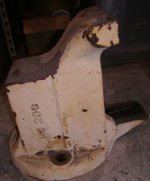John Ruth is correct about the term "garter". It is used in mechanical work to describe a variety of similar components. The most common usage is the "garter spring" used to keep a lip type seal snug around a rod or shaft.
Athol also used a similar type of garter to hold the vise screw in place in the moveable jaw when opening the vise. Athol used more of a wire spring-clip that engaged a groove on the shank of the vise screw.
A few years back, I found a 3 1/2" Athol vise along the roadside in a pile for metal pick-up. It was not beat up, but the garter was missing. I suppose I could have made an effort to size up a circlip to replace the missing garter. What I did instead was to machine a shaft collar. I bored the collar to a good fit on the shank of the vise screw, and tapped it for two setscrews at 90 degrees. The groove for the garter was too close to the inner face of the movable jaw to catch with the setscrews. I used a ball end mill to make a couple of very shallow dimples in the shank of the vise screw (figuring the ball end mill would not create the kind of stress risers or discontinuity that a drilled dimple would). The collar I made had to have some milled relief flats on it to fit into the pocket in the jaw casting.
The overall repair is hidden & works fine. Rather than chase around trying to hunt down the correct garter (or trying to make one), perhaps this idea of a shaft collar would work on your Reed Vise.
I am unsure about Reed's designs of vises. Some of the machinist vises used a "crowfoot" to retain the vise screw in the movable jaw. The crowfoot (my choice of term since it looks like a crowfoot wrench) looks somewhat like a shifter fork in a geared transmission.
The crowfoot was located between the "ball" at the end of the vise screw and the body of the moveable jaw. A groove was machined into the shank of the vise screw, and the crowfoot entered this groove. The crowfoot was secured to the front of the moveable jaw by a capscrew. It was a more expensive way to go about making a vise, and required a bit more meat in the front of the moveable jaw casting to make a pad for the crowfoot.
I think most of the machinist vise manufacturers got away from the crowfoot in favor of using some sort of garter. It saved quite a bit of machining, and popped right into place on the shank of the vise screw. The heavier duty vises from the old-line makers like Prentiss tended to stay with the crowfoot. I have a "Simplex" 4 1/2" vise on my bench in my home shop. It has the crowfoot. I have a new/unused Columbian 4 1/2" swivel base combination vise (new in '72, a virgin ever since). It has the same crowfoot.
I may be off base on this, but I think Reed used to incorporate the steel jaw plates into the castings of the jaws. The jaws were likely cast of a "semi steel" or malleable iron alloy. The patterns for the jaw castings likely had what the patternmakers call a "core print" on them to provide space in the mold for the jaw plates. The jaw plates likely had some kind of serrated projection that stuck into the mold cavity. When the molds were poured, the molten iron incorporated the serrated projection on the jaw plate. As the casting cooled and the iron shrank, it tended to really lock the jaw plates in. I do not know what alloy steel or process Reed or the other makers used for these "imbedded" jaw plates. Suffice it to say they are generally quite hard, despite the slow cooling of the castings that incorporated them.
I have not seen too many Reed vises. I used to see them more in old powerplants, maintainence shops, weld shops, or heavy equipment and truck garages. Usually, the old Reed vises had taken a beating externally, but were still fine. Reed was (and still is) known for their pipe tools- wrenches, pipe vises, and similar. I think because of this, the Reed vises tended to find their way into the powerplants and maintainence shops where piepfitting and boiler repairs were more the daily work. I think Reed made about the heaviest duty machinist vises in the USA.
Joe Michaels





